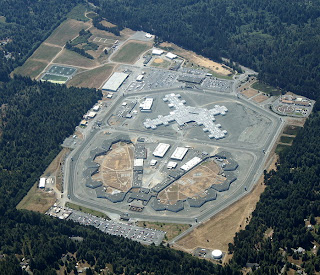Our daily correspondence sometimes includes letters from inmates, informing us of the situation within walls. Recently, several letters have arrived from Pelican Bay Prison, from inmates incarcerated at the prison’s Security Housing Unit (SHU). A form of supermax incarceration, SHU consists of 22-23 hours of solitary confinement a day.
SHU has been designed for escape risks, violent or threatening inmates, and “members of disruptive groups”, such as gangs. There are some challenges involved in appropriately classifying inmates into SHU or general population. Classification is a crucial issue, because research on solitary confinement consistently shows that SHU-like conditions adversely and severely impact inmates’ mental health (here’s a 1993 piece by Craig Haney on this and a 2009 New Yorker article reviewing research and including interviews).
The concept of solitary confinement is not new. Our visit notes from Eastern State Penitentiary in PA might be useful. However, the purpose has changed. While the original ideology behind solitary confinement was to provoke repentance, rebirth, and rehabilitation, current supermax isolation conditions are aimed at incapacitation and safety.
Here is Laura Sullivan’s 2006 NPR story about SHU and the solitary conditions. The institution currently exceeds its design capacity by approximately 1,200 inmates.


4 Comments
The lack of precise and current information about segregated housing and your usage of CDCR terminology bother me. CDCR does not have any supermax units. PBSP houses Level IV inmates, same as Corcorcan, SVSP, SQSP, CSP-SAC, and others. The first article you link to here is more than ten years old, the next is from seven years ago. Haney's premise and conclusions seems flawed since inmates are placed in Ad. Seg. for the very combative behavior and inexplicable rage that he alleges was caused by their housing. I'm more surprised he identified these issues in less than ninety percent of his subjects.
The Security Housing Unit at PBSP is just one of many Segregated Housing Units (SHU) of different types in the state. Current count at PBSP is 3,365, 141.4% of capacity and 985 inmates more than it's designed to hold, not 1,200. It's hardly the most overcrowded adult institution either. That'd be Avenal at 229% and 3,767 inmates over design capacity. PBSP is the third LEAST crowded male adult CDCR institution.
See California Code of Regulations, Title 15, Division 3, Article 7 for better understanding of segregated housing and classification in a CDCR institution.
Thanks for the information, Anonymous. Haney's work often argues against the bias you identify; his premise is that the behavior he points to is distinctively different from the one that causes the segregation to begin with.
As to the definition of SHU as supermax, the discussion here was not aimed to be faithful to CDCR categorization, but rather to convey what sort of incarceration style we're referring to. The scholarship regarding these methods invariably refers to SHU and Supermax as systems constructed around the same ideology and yielding the same pathologies.
As to the overcrowding data, thanks for the more accurate, and not much more encouraging, updated information – what is the source? I got my count from the CDCR website.
Thanks for your thoughtful response. Never read Haney's work beyond the mention in the article you linked to so won't say anything further but that in my experience, behavior and attitudes of that type predates an inmate's placement in Ad. Seg.
No, not more encouraging but inmates at PBSP by virtue of their classifications and incarceration scores usually enjoy less crowding than the average inmate. In response to your question,you can get counts updated monthly at http://www.cdcr.ca.gov/Reports_Research/Offender_Information_Services_Branch/Monthly/Monthly_Tpop1a_Archive.asp
I would dispute Anonymous' assertion that CDCR has no "supermax." The Pelican Bay SHU would seem to fit precisely the term "supermax" – both in its design and in it's operations. Just read Madrid v. Gomez and also take a visit. To be "fair" to CDCR, the SHU's at other institutions are less draconian (inmates may have belongings and cellmates). Anonymous is correct that PBSP SHU is not the only kind of seg housing. In fact, approximately 5% of CDCR's population is in Administrative Segregation at any one time. AdSeg can, arguably, be worse than SHU for a number of reasons. Inmates in AdSeg typically do not have their belongings, they may be there for non-disciplinary reasons (e.g. safety only), and they often are kept in AdSeg for extended lengths of time (>90 days) for administrative reasons only (maybe the local DA has not picked up the case). Another fact of segregated housing (not SHU) is that the proportion of inmates who participate in the CDCR mental Health system is disproportionately higher in AdSeg than in General Population. Inmates with severe mental health problems are not excluded from Seg (and I do not mean that they should categorically be) but they are placed in AdSeg at a higher rate than non-mental health patients.
Critics of Haney's work are correct that he does not ground his conclusions in empirical data, rather his conclusions are based on non-systematic, qualitative research that does not meet some standards of academic rigor. However, the basic points he makes are probably accurate – the problem is that we do not know who and under exactly what circumstances an inmate may develop mental health problems in SHU. Mental Health screening and monitoring in AdSeg and SHU is fairly rigorous, but there are custodial issues that do not take into account the harsh conditions of confinement in SHU and AdSeg.
CDCR has a long way to go to improve conditions in its prisons – and segregated housing is one piece.
(I work for CDCR mental health)